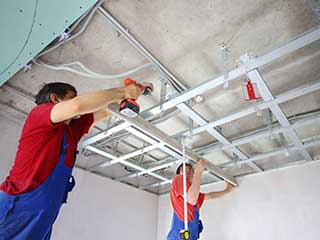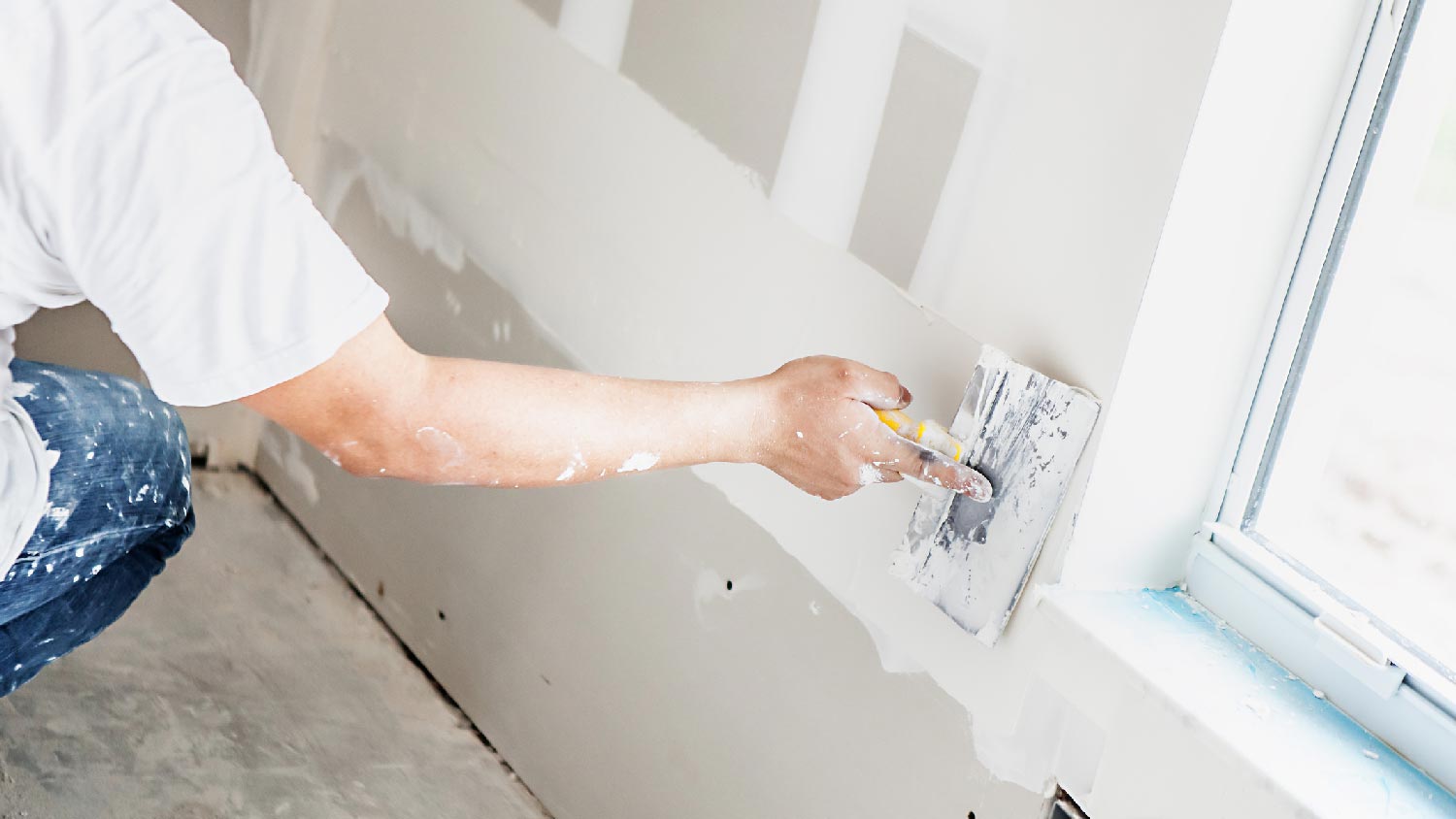Learn about how Drywall Installation Ogden Utah can enhance professional painting services.
Essential Tips for Effective Drywall Fixing and Installation Techniques
Efficient drywall repair work and installation requires a mindful strategy. Recognizing the sorts of drywall and having the right devices is essential. Correct techniques and exact measurements can significantly impact the end result. Several ignore crucial steps like taping and fining sand, which can make or damage the last appearance. As projects proceed, usual obstacles might develop that require interest. Discovering these suggestions can bring about a much more refined and effective coating.
Recognizing Different Types of Drywall
Understanding the numerous sorts of drywall is necessary for any kind of effective repair work or setup job. Drywall, generally called gypsum board, is available in several varieties customized for particular applications. Criterion drywall is the most commonly made use of kind, suitable for general interior walls and ceilings. Moisture-resistant drywall, usually environment-friendly in color, is developed for locations susceptible to humidity, such as washrooms and cooking areas. Fire-resistant drywall, normally tinted pink or purple, is crafted to hold up against higher temperatures and is usually used in garages or near furnaces. Additionally, soundproof drywall helps in reducing noise transmission, making it suitable for multi-family homes or recording studios. Specialized drywall, like concrete board, is made use of in damp locations like showers or bathtub surrounds. Comprehending these types helps in choosing the appropriate material for each project, making certain longevity and effectiveness in repair services or new installments.
Necessary Tools for Drywall Repair Service and Installation
Having the right tools is essential for effective drywall fixing and installation. A top quality energy knife is vital for cutting drywall sheets specifically. A drywall T-square assists assure straight edges, while a taping blade is needed for applying joint substance smoothly over seams. In addition, a drywall saw allows for eliminating harmed areas or fitting drywall around fixtures.
For hanging drywall, a power drill with drywall screws is vital, as it allows safe and secure and quick installment. A level is additionally crucial to verify that the drywall is straight and correctly aligned. Once it has actually dried out, a fining sand block or pole sander is important for smoothing out joint compound. A gauging tape is important for exact measurements, stopping waste and guaranteeing an appropriate fit. Geared up with these tools, individuals can take on drywall jobs effectively, leading to professional-looking results.
Step-by-Step Overview to Repairing Holes and Cracks
When attending to holes and cracks in drywall, having the right tools and products is vital for a successful fixing. This guide outlines the essential items and provides a clear, detailed process to efficiently restore the surface. Comprehending these elements will aid guarantee a seamless finish and lasting results.
Devices and Materials Needed
A fully equipped toolkit is important for reliable drywall repair service and installment. Secret devices consist of an energy knife for cutting drywall, a tape action to guarantee accurate sizing, and a drywall saw for bigger openings. A putty blade is necessary for using joint compound efficiently, while a sanding block or post sander aids achieve a smooth finish. For patching, a roll of fiberglass harmonize tape or paper tape is needed to enhance joints. In addition, a drill and screws are needed for safeguarding new drywall pieces. Important products consist of joint substance, primer, and paint to complete the repair. Having these tools and materials on hand ensures a smoother, a lot more reliable repair process, yielding professional-looking outcomes.
Repair Refine Actions
Repairing holes and cracks in drywall needs a systematic strategy to assure a smooth surface. Initially, the area bordering the damage ought to be cleansed thoroughly to get rid of dirt and particles. Next, for tiny splits, a putty knife is made use of to use a joint compound uniformly over the location. For larger holes, a spot is necessary; the harmed area is cut out, and a new piece of drywall is suited place, protected with screws. Once the spot remains in position, joint substance is used to mix the edges. After drying out, sanding the location smooth is essential. Lastly, the repaired surface area ought to be keyed and painted to match the surrounding wall, ensuring an inconspicuous repair.
Strategies for Putting Up Drywall Panels
Mounting drywall panels requires mindful preparation and accurate implementation to ensure a specialist and smooth finish. It is vital to determine the wall room properly and reduce the panels to fit, guaranteeing that they line up with the studs. Positioning the panels horizontally is normally recommended, as this can boost the architectural honesty and decrease the number of seams.
Making use of drywall screws, installers must safeguard the panels every 16 inches along the studs, making certain a firm hold. It is essential to avoid overdriving the screws, which can harm the paper surface area. For edges and sides, making use of an utility blade permits for tidy cuts and a snug fit.

Finishing Touches: Taping, Mudding, and Sanding
When the drywall panels are firmly in position, the next vital step entails the complements of taping, mudding, and sanding. Taping is vital for developing a seamless change between panels and concealing joints. A quality drywall tape, either paper or fiberglass harmonize, ought to be used over the seams, guaranteeing it adheres correctly to the mud that will certainly be used next.
Mudding, or applying joint substance, adheres to the taping process. This substance fills voids and ravel the surface. A very first layer ought to be used kindly, feathering the edges to blend with the drywall. After the first layer dries out, succeeding layers may be required for a remarkable surface.
Fining sand is needed to attain a smooth surface. A fine-grit sandpaper should be utilized to delicately ravel any kind of imperfections. Treatment needs to be required to avoid over-sanding, which can harm the drywall - Drywall Installation Ogden Utah. Appropriately performed, these ending up touches develop a specialist appearance ready for paint
Tips for Preserving Your Drywall After Installation
Keeping drywall after installment is crucial to preserving its appearance and architectural stability. Routine cleaning is needed; dust and dirt can accumulate, so mild wiping with a moist towel is advised. House owners must also evaluate for any indications of dampness or mold and mildew, particularly in high-humidity locations like washrooms and kitchens. If any damage happens, it's crucial to address it promptly to avoid more issues.
Utilizing furniture pads can assist protect against scratches or dents from hefty items. Furthermore, painting the drywall with a premium, washable paint gives an additional layer of defense and makes future cleaning much easier. Stay clear of using rough cleaners or devices, as these can harm the surface. Maintaining a steady interior climate with proper moisture levels will certainly help avoid deforming or cracking over time. By adhering to these suggestions, one can guarantee that drywall stays in exceptional problem for several years ahead.
Often Asked Inquiries
The Length Of Time Does Drywall Require To Fully Dry After Installation?

Can I Set Up Drywall Over Existing Drywall?
Yes, drywall can be mounted over existing drywall, but it is necessary to guarantee the underlying surface area is safe and secure and sufficiently prepared. This method can boost insulation and lower setup time, though it may include weight.
What Is the Ideal Method to Soundproof Drywall?
The finest way to soundproof drywall involves utilizing specialized soundproofing materials, such as durable channels, acoustic caulk, and sound-dampening drywall. These strategies efficiently lessen sound transmission between areas, boosting general acoustic performance in living areas.
How Do I Pick the Right Drywall Density?
To pick the best drywall thickness, think about the application and location. Standard click here household walls generally use 1/2 inch, while ceilings or specialized locations may require 5/8 inch for additional strength and soundproofing capacities.
Are There Eco-Friendly Drywall Options Available?
Yes, environment-friendly drywall options are available. These consist of items made from recycled materials, plaster boards with low unpredictable natural substances (VOCs), and those using lasting manufacturing processes, providing environmentally-conscious selections for building and construction and improvement projects.
Having the right tools is necessary for efficient drywall repair and setup. For hanging drywall, a power drill with drywall screws is crucial, as it allows protected and fast installment. Key devices consist of an energy knife for reducing drywall, a tape action to ensure exact sizing, and a drywall saw for larger openings. Yes, drywall can be set up over existing drywall, yet it is crucial to ensure the underlying surface area is safe and effectively prepared. The best means to soundproof drywall involves making use of specialized soundproofing products, such as resistant channels, acoustic caulk, and sound-dampening drywall.